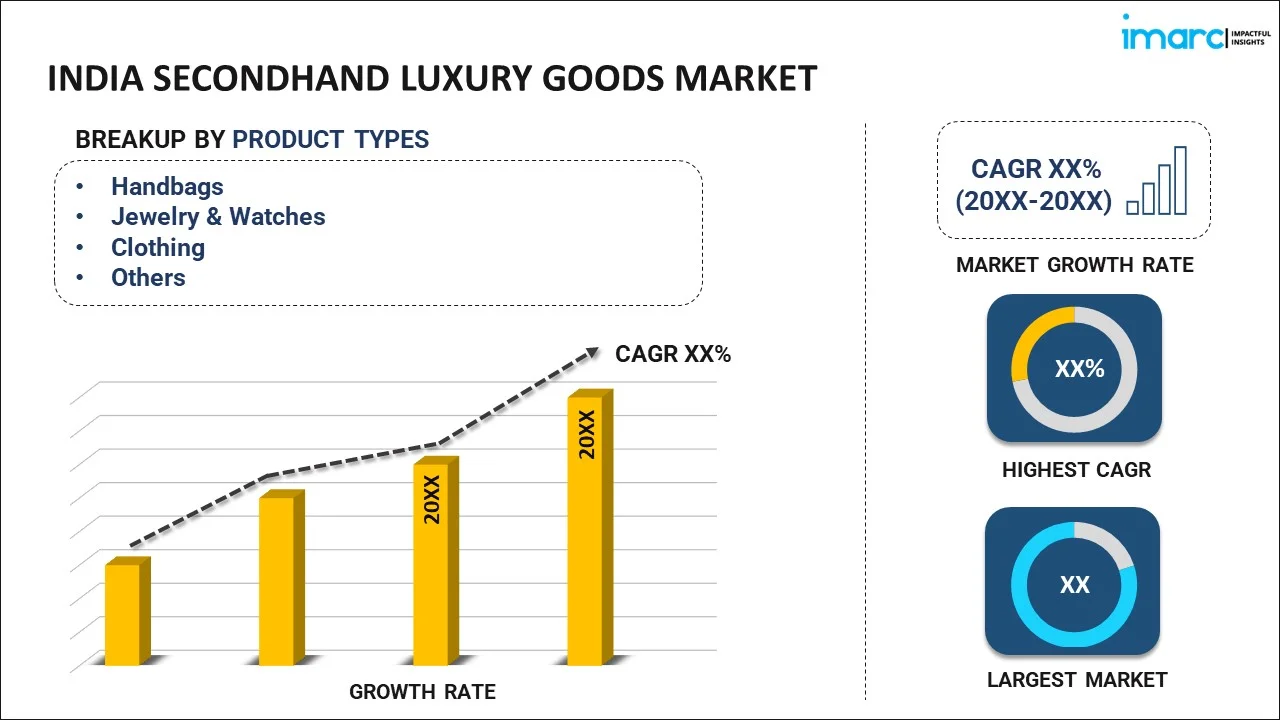
India Secondhand Luxury Goods Market Report by Product Type (Handbags, Jewelry & Watches, Clothing, Small Leather Goods, Footwear, Accessories, and Others), Demography (Women, Men, Unisex), Distribution Channel (Offline, Online), and Region 2025-2033
Market Overview:
The India secondhand luxury goods market size reached USD 683.1 Million in 2024. Looking forward, IMARC Group expects the market to reach USD 1,674.5 Million by 2033, exhibiting a growth rate (CAGR) of 9.95% during 2025-2033.
|
Report Attribute
|
Key Statistics
|
|---|---|
|
Base Year
|
2024
|
|
Forecast Years
|
2025-2033
|
|
Historical Years
|
2019-2024
|
|
Market Size in 2024
|
USD 683.1 Million |
|
Market Forecast in 2033
|
USD 1,674.5 Million |
| Market Growth Rate 2025-2033 | 9.95% |
Secondhand luxury goods are high-end and premium products purchased by the second and later end users. These goods include antique furniture, footwear, apparel, artwork, jewelry and fashion accessories like bags and watches. They also provide an extended warranty period and offer economic benefits to the seller as they can be resold instead of being discarded. They also help reduce carbon footprints and minimize the dependence on raw materials while lowering waste production levels.
The India secondhand luxury goods market is primarily driven by the growing influence of western fashion trends, improving living standards and rising disposable incomes of the consumers. Besides this, with the rising environmental concerns, individuals are shifting toward secondhand luxury products, which decrease the volume of waste sent to landfills. Apart from this, the growing adoption of high-end fashion accessories and clothing due to the rising accessibility and affordability is also catalyzing the market growth. Furthermore, the introduction of various international e-commerce platforms that offer overseas delivery options has increased the sales of pre-owned luxury goods.
Key Market Segmentation:
IMARC Group provides an analysis of the key trends in each sub-segment of the India secondhand luxury goods market report, along with forecasts at the country and regional level from 2025-2033. Our report has categorized the market based on product type, demography and distribution channel.
Breakup by Product Type:

- Handbags
- Jewelry & Watches
- Clothing
- Small Leather Goods
- Footwear
- Accessories
- Others
Breakup by Demography:
- Women
- Men
- Unisex
Breakup by Distribution Channel:
- Offline
- Online
Breakup by Region:
- North India
- West and Central India
- South India
- East India
Competitive Landscape:
The competitive landscape of the industry has also been examined along with the profiles of the key players.
Report Coverage:
| Report Features | Details |
|---|---|
| Base Year of the Analysis | 2024 |
| Historical Period | 2019-2024 |
| Forecast Period | 2025-2033 |
| Units | Million USD |
| Segment Coverage | Product Type, Demography, Distribution Channel, Region |
| Region Covered | North India, West and Central India, South India, East India |
| Customization Scope | 10% Free Customization |
| Post-Sale Analyst Support | 10-12 Weeks |
| Delivery Format | PDF and Excel through Email (We can also provide the editable version of the report in PPT/Word format on special request) |
Key Questions Answered in This Report
The India secondhand luxury goods market was valued at USD 683.1 Million in 2024.
We expect the India secondhand luxury goods market to exhibit a CAGR of 9.95% during 2025-2033.
The increasing demand for high-end fashion accessories at lower prices, along with the emerging trend of re-selling unwanted luxury goods, is primarily driving the India secondhand luxury goods market.
The sudden outbreak of the COVID-19 pandemic has led to the rising utilization of several online retail platforms to provide a safe and reliable environment for customers to re-sell and buy secondhand luxury goods across the nation.
Based on the product type, the India secondhand luxury goods market can be categorized into handbags, jewelry & watches, clothing, small leather goods, footwear, accessories, and others. Currently, handbags account for the majority of the total market share.
Based on the demography, the India secondhand luxury goods market has been segregated into women, men, and unisex. Among these, women currently exhibit a clear dominance in the market.
Based on the distribution channel, the India secondhand luxury goods market can be bifurcated into offline and online. Currently, offline holds the largest market share.
On a regional level, the market has been classified into North India, West and Central India, South India, and East India, where North India currently dominates the India secondhand luxury goods market.
Need more help?
- Speak to our experienced analysts for insights on the current market scenarios.
- Include additional segments and countries to customize the report as per your requirement.
- Gain an unparalleled competitive advantage in your domain by understanding how to utilize the report and positively impacting your operations and revenue.
- For further assistance, please connect with our analysts.
 Inquire Before Buying
Inquire Before Buying
 Speak to an Analyst
Speak to an Analyst
 Request Brochure
Request Brochure
 Request Customization
Request Customization




.webp)




.webp)












